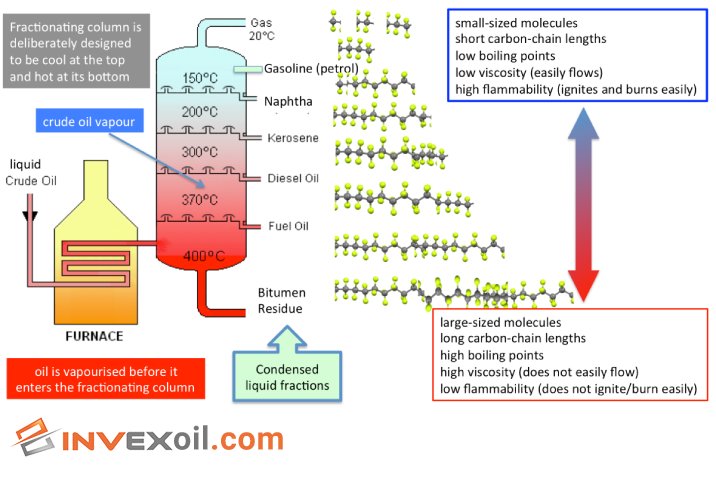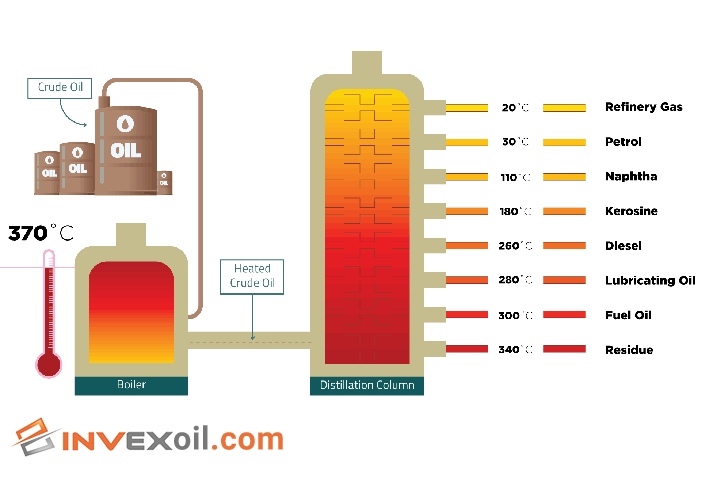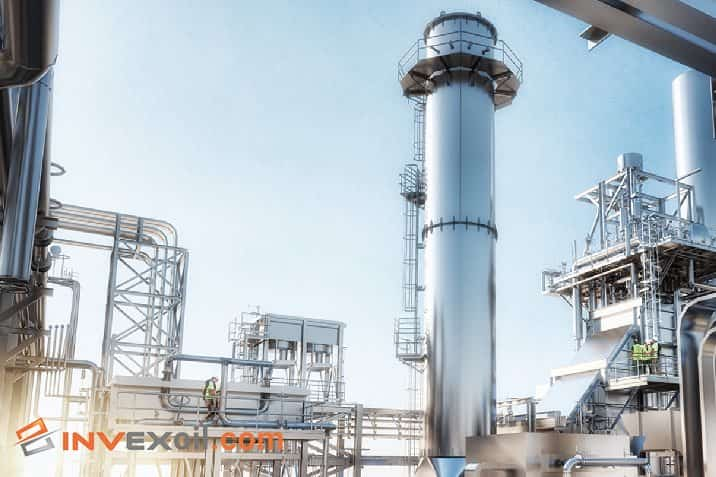What is crude oil made of? Crude oil is a complex mixture of hydrocarbons, including alkanes, aromatics, resins, and asphaltenes. To turn this raw material into usable products, it needs to undergo refining at an oil re refinery. At an oil refinery, crude oil is separated into various fractions through the process of fractional distillation. Each fraction is then processed further using various conversion processes to produce a range of end products, including gasoline, diesel fuel, jet fuel, and lubricants.
Table of Contents
Formation of Crude Oil
Crude oil is a remarkable substance that undergoes a complex formation process over millions of years.
What is Crude Oil Made Of? The Origins!
Crude oil is primarily composed of hydrocarbons, organic compounds consisting of hydrogen and carbon atoms. These hydrocarbons form through the decomposition and transformation of ancient marine plants and microscopic organisms. Over time, the organic matter accumulates and becomes buried under layers of sediment, subjected to immense heat and pressure. This transformative process results in the formation of crude oil reservoirs deep within the Earth’s crust. The specific composition of crude oil varies depending on factors such as the source rocks and geological conditions during its formation.
Chemical Composition of Crude Oil
Crude oil’s chemical composition is a complex blend of various components. Understanding what crude oil is made of is essential for unraveling its intricate nature.
This table can help you better understand the Chemical Components of Crude Oil, which can help you to understand this part more easily.
| Chemical Component | Description |
| Alkanes | Straight-chain or branched hydrocarbons consisting of carbon and hydrogen atoms. They provide energy and serve as the main component of gasoline and diesel fuel. |
| Aromatics | Cyclic hydrocarbons with a ring structure. They are important for the production of chemicals, solvents, and additives for gasoline. |
| Resins | Complex compounds that contribute to the viscosity and adhesiveness of crude oil. They are also used in the production of adhesives and coatings. |
| Asphaltenes | High-molecular-weight compounds that give crude oil its black, viscous nature. They have applications in the production of asphalt and bitumen. |
| Sulfur Compounds | Compounds containing sulfur that can have detrimental environmental effects when released during combustion. Reducing sulfur content is a key focus in refining processes. |
| Nitrogen Compounds | Compounds containing nitrogen that can have negative impacts on refining processes and the performance of end products. Minimizing nitrogen content is important for quality control. |
| Oxygen Compounds | Compounds containing oxygen, such as organic acids and alcohols. Their presence affects the stability and properties of crude oil and its derivatives. |
Unraveling the Complex Chemical Makeup Crude Oil
Crude oil is primarily composed of hydrocarbons, which are the fundamental building blocks responsible for its properties and characteristics. These hydrocarbons include different types such as alkanes, aromatics, resins, and asphaltenes. Additionally, crude oil may contain trace amounts of sulfur, nitrogen, and oxygen compounds. The specific combination and ratios of these components vary among different crude oil types, contributing to their unique qualities and uses.
Hydrocarbons, The Building Blocks of Crude Oil
Hydrocarbons form the backbone of crude oil. They consist of chains or rings of carbon atoms bonded to hydrogen atoms. Alkanes, the simplest hydrocarbons, exhibit a linear structure, while aromatics feature a ring structure. These hydrocarbons provide crude oil with its energy-rich properties and make it a valuable resource for fuel production. The varying lengths and structures of hydrocarbon chains in crude oil give rise to different fractions during refining, each with distinct characteristics and applications.
Understanding the chemical composition of crude oil and the significance of hydrocarbons allows for better comprehension of its properties and enables efficient processing and utilization.
Primary Components of Crude Oil
Crude oil consists of various primary components, including hydrocarbons and heavier compounds. Understanding these components provides valuable insights into the nature and properties of crude oil.
Minor Components and Impurities in Crude Oil
Crude oil consists not only of major components like hydrocarbons but also contains various minor components and impurities. Understanding the presence and impact of these elements is crucial in comprehending the properties and applications of crude oil.
What is Crude Oil Made Of Examining the Presence of Minor Components and Impurities
Apart from hydrocarbons, crude oil may contain minor components and impurities such as sulfur, nitrogen, oxygen compounds, metals, and other contaminants. These elements are present in varying amounts and can have significant effects on the quality and usability of crude oil.
Sulfur: Impact of Sulfur Content in Crude Oil
Sulfur is one of the most notable impurities in crude oil. Its presence can lead to the formation of sulfur compounds, which have environmental and health implications. The sulfur content in crude oil affects its quality and refining processes, as well as the emissions produced when it is used as a fuel.
Nitrogen: Understanding the Presence of Nitrogen in Crude Oil
Nitrogen is another minor component . Its presence can lead to challenges during refining and processing, as nitrogen compounds can cause corrosion, catalyst deactivation, and environmental concerns. Managing nitrogen content is crucial to ensure the efficiency and performance of crude oil.
Oxygen: The Role of Oxygen Compounds in Crude Oil
Oxygen compounds, such as organic acids and alcohols, are present in small amounts in crude oil. These compounds can impact the stability, viscosity, and combustion properties of crude oil. Proper management of oxygen content is essential to avoid operational challenges in the refining and utilization of crude oil.
Metals and Other Contaminants: Impurities in Crude Oil
Crude oil may also contain trace amounts of metals like nickel, vanadium, and iron, along with other contaminants. These impurities can have detrimental effects on refining processes and can lead to catalyst poisoning, equipment damage, and reduced product quality. Effective removal of these metals and contaminants is necessary for optimal crude oil utilization
What is Crude Oil Made Of? Major Hydrocarbon Types!
Crude oil is primarily composed of hydrocarbons, organic compounds made up of hydrogen and carbon atoms. These hydrocarbons can be categorized into major types, such as alkanes, aromatics, resins, and asphaltenes. Each type plays a significant role in determining the characteristics and applications of crude oil.
Alkanes, The Most Abundant Hydrocarbons in Crude Oil
Alkanes are the predominant hydrocarbons in crude oil. They consist of straight or branched chains of carbon atoms bonded to hydrogen atoms. The abundance of alkanes in crude oil makes them crucial for energy production and fuels, including gasoline and diesel.
This is a table about Common Alkanes in Crude Oil
| Alkane | Chemical Formula | Boiling Point (°C) | Common Applications |
| Methane | CH4 | -161.5 | Natural gas, fuel |
| Ethane | C2H6 | -88.6 | Petrochemical feedstock, fuel |
| Propane | C3H8 | -42.1 | LPG, heating fuel |
| Butane | C4H10 | -0.5 | LPG, fuel |
| Pentane | C5H12 | 36.1 | Solvent, component in gasoline |
| Hexane | C6H14 | 68.7 | The solvent, component in gasoline |
Overview of Common Alkanes
Common alkanes found in crude oil include methane, ethane, propane, butane, pentane, and hexane. These alkanes have varying carbon chain lengths, affecting their boiling points and physical properties. They serve as important feedstocks for the production of petrochemicals and are used as fuel sources in various industries.
Understanding the Role of Aromatics in Crude Oil
Aromatics are another significant group of hydrocarbons present in crude oil. They contain one or more aromatic rings, which contribute to their distinct properties and chemical reactivity. Aromatics are essential for the production of chemicals, solvents, and additives in industries such as pharmaceuticals and plastics.
Common Aromatic Compounds in Crude Oil
Common aromatic compounds found in crude oil include benzene, toluene, ethylbenzene, and xylene (collectively known as BTEX). These compounds are valuable raw materials for the production of plastics, synthetic fibers, dyes, and other industrial products.
And this is a table of Common Aromatic Compounds in Crude Oil.
| Aromatic Compound | Chemical Formula | Common Applications |
| Benzene | C6H6 | Petrochemicals, solvents, plastics |
| Toluene | C7H8 | Solvents, fuel additives |
| Ethylbenzene | C8H10 | Production of styrene, polymers |
| Xylene | C8H10 | Solvents, chemicals, plastics |
Resins and Asphaltenes, the Heavier Components of Crude Oil
Resins and asphaltenes are the heavier components of crude oil. Resins contribute to the viscosity and adhesiveness of crude oil, while asphaltenes impart their black, viscous nature. These components have applications in the production of adhesives, coatings, and asphalt.
Properties and Uses of Resins and Asphaltenes
Resins and asphaltenes exhibit unique properties that make them suitable for various applications. Resins provide adhesive properties and are used in the formulation of paints, inks, and varnishes. Asphaltenes, on the other hand, find use in the production of asphalt and bitumen for road construction and waterproofing.
Physical Properties of Crude Oil
Understanding the physical properties of crude oil is essential in assessing its characteristics and determining its suitability for various applications.
What is Crude Oil Made Of: Exploring the Physical Properties
Crude oil exhibits several key physical properties that define its behavior and usability. These properties include density, viscosity, flash point, pour point, and API gravity.
Density: Measuring the Weight of Crude Oil
we have to know more about density. Density refers to the mass of crude oil per unit volume and provides insights into its heaviness or lightness. It is an important parameter for transportation, storage, and blending purposes.
This is a table about the density of crude oil.
| Crude Oil Grade | Density (kg/m³) |
| Light Crude | 820 – 920 |
| Medium Crude | 900 – 950 |
| Heavy Crude | 920 – 1050 |
| Extra Heavy Crude | 950 – 1150 |
Viscosity: Examining the Flow Characteristics of Crude Oil
Viscosity measures the resistance of crude oil to flow. It affects pumping, pipeline transportation, and processing operations. Higher viscosity indicates thicker and more resistant oil.
Flash Point: Understanding the Ignition Point of Crude Oil
The flash point represents the lowest temperature at which crude oil emits flammable vapors that can ignite when exposed to an open flame or spark. It is critical for safety considerations during storage and handling.
Pour Point: Analyzing the Temperature at which Crude Oil Freezes
The pour point is the lowest temperature at which crude oil becomes solid and loses its flowability. It influences the ability to transport and handle crude oil in colder environments.
API Gravity: Determining the Density of Crude Oil
API gravity is a measurement scale used to determine the density of crude oil relative to water. It helps classify crude oil as light, medium, or heavy, impacting its refining and pricing.
Distillation, Separating Crude Oil into Fractions!
Refining crude oil is the process of converting it into usable products through various techniques. By understanding what crude oil is made of, we can delve into the refining process and its significance in producing valuable substances.
Crude oil, composed of hydrocarbons and impurities, undergoes refining to transform it into valuable products such as gasoline, diesel, and jet fuel. The refining process involves several stages, with distillation being a key step.
Distillation is a crucial process in refining, which separates crude oil into different fractions based on their boiling points. Lighter fractions, such as gasoline, have lower boiling points, while heavier fractions, like diesel and fuel oil, have higher boiling points.
There is a table related to Fraction Distillation Points to compare parts of this header.
| Fraction | Boiling Point Range (°C) |
| Gasoline | 40-205 |
| Diesel | 205-345 |
| Fuel Oil | Above 345 |
| Kerosene | 175-315 |
| Liquefied Petroleum Gas (LPG) | Below 40 |
Distillation Process
During distillation, the crude oil is heated, and the resulting vapors are condensed at specific temperatures to obtain various fractions. Common distillation points include the separation of gasoline at around 40-205°C, diesel at 205-345°C, and fuel oil at temperatures above 345°C.
Enhancing the Quality of Crude Oil Products
Conversion processes further refine the fractions obtained from distillation to improve their quality and properties. These processes include catalytic cracking, hydrocracking, and coking, which modify the molecular structure of the fractions to enhance their performance.
This is a brief of whole article about What is crude oil made of, that you can use it for remember what you read in this article.
| Topic | Summary |
| Formation of Crude Oil | Origin and geological processes leading to the formation of crude oil |
| Chemical Composition of Crude Oil | Major components: hydrocarbons (alkanes, aromatics), minor impurities |
| Physical Properties of Crude Oil | Density, viscosity, flash point, pour point, API gravity |
| Refining Crude Oil | Conversion of crude oil into usable products through distillation |
| Fraction Distillation Points | Distillation process and important points for separating crude oil |
| Conclusion | Understanding crude oil’s composition, properties, and refining process |
Conclusion
understanding What is crude oil made of? includes many parts. That’s including its chemical composition, physical properties, and formation process, which is crucial. By examining its components, such as hydrocarbons and impurities, and exploring its properties like density and viscosity, we can appreciate the refining process that converts crude oil into valuable products. This knowledge enhances our understanding of the oil industry and its impact on various sectors.
FAQ
What are the primary components of crude oil?
Crude oil is primarily made up of hydrocarbons, which are organic compounds consisting of hydrogen and carbon atoms.
Are there any other substances or impurities present in crude oil?
Yes, crude oil may also contain minor components and impurities such as sulfur, nitrogen, oxygen compounds, and metals.
How do the physical properties of crude oil contribute to its characteristics?
The physical properties of crude oil, including density, viscosity, flash point, pour point, and API gravity, determine its weight, flow characteristics, ignition point, freezing temperature, and density measurement.







In Onliner.co, Our team with 12 professional members in each of content creation, on-page, off-page, and technical domain has always been able to achieve customer satisfaction with 12 years of experience in SEO. In the content creation sector, our expert writers are up to date and experienced to provide a high quality and unique contents.